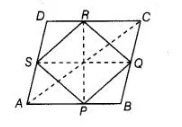The figure obtained by joining the mid-points of the sides of a rhombus, taken in order, is
(a) a rhombus
(b) a rectangle
(c) a square
(d) any parallelogram
(b) Let $A B C D$ be a rhombus in which $P, Q, R$ and $S$ are the mid-points of sides $A B, B C, C D$ and $D A$, respectively.

Join $A C, P R$ and $S Q$
In $\triangle A B C, P$ is the mid-point of $A B$ and $Q$ is the mid-point of $B C$.
$\Rightarrow \quad P Q \| A C$ and $P Q=\frac{1}{2} A C \quad[$ by using mid-point theorem] ...(i)
Similarly, in $\triangle D A C$,
$S R \| A C$ and $S R=\frac{1}{2} A C$ ...(ii)
From Eqs. (i) and (ii),
$P Q^{\prime} \| S R$ and $P Q=S R$
So, $P Q R S$ is a parallelogram.
Also, $A B Q S$ is a parallelogram.
$\Rightarrow \quad A B=S Q$ .....(iii)
[opposite sides of a parallelogram are equal]
Similarly, $P B C R$ is a parallelogram.
$B C=P R$ [opposite sides of a parallelogram are equal]
$\Rightarrow \quad A B=P R \quad[\because B C=A B$ sides of a rhombus $]$
$\Rightarrow \quad S Q=P R \quad$ [from Eq. (iii)]
So, the diagonals of a parallelogram are equal. Hence, PQRS is a rectangle.
